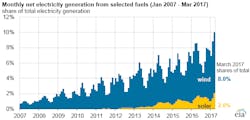Natural Gas Edged Coal Power in 2016; While Wind and Solar Topped 10% for First Time
Two recent documents from the U.S. Energy Information Administration (EIA) continue to illustrate the rise of natural gas and renewable energy in the domestic electricity sector.
Natural gas accounted for more domestic electric generation than coal during 2016 and, earlier this year, wind and solar power together provided more than 10% of the power mix for the first time, according to EIA.
In 2016, natural gas provided 34% of total electricity generation, surpassing coal to become the leading generation source, EIA said June 16. Coal generated about 30% of U.S. electricity in 2016 and the typical U.S. coal power unit is about 39 years old, EIA has said previously.
Nuclear energy generated almost 20% of domestic electricity during 2016 and all renewables, led by hydro with 6.5%, combined to generate almost 15% of the nation’s electric output in 2016.
Natural gas first exceeded coal as the most common electricity fuel on a monthly basis in April 2015 and on an annual basis in 2016. The increase in natural gas generation since 2005 is primarily a result of the continued cost competitiveness of natural gas relative to coal.
Natural gas-fired capacity is widely distributed across the United States. Every state except Vermont has at least one natural gas plant.
In the past 15 years, nearly 228 gigawatts (GW) of capacity fueled by natural gas was added, far exceeding retirements of 54 GW.
Coal’s fortunes, however, have been heading in the opposite direction. Over that same 15-year period, 20 GW of coal-fired capacity was added, while more than 53 GW was retired.
Regionally, coal remains the dominant fuel for electricity generation in the Midwest, although its share has decreased in recent years. In the Northeast, electricity generation with natural gas has exceeded coal-fired generation since February 2011. In the South, monthly natural gas generation surpassed that of coal in every month since January 2015. In the West, electricity generated by coal and natural gas has remained in close competition over the past decade; however, natural gas exceeded coal in the power sector for 11 months during 2016.
For the first time, monthly electricity generation from wind and solar (including utility-scale plants and small-scale systems) exceeded 10% of total electricity generation in the United States, based on March data in EIA’s Electric Power Monthly reported on June 14.
Electricity generation from both energy sources has grown with increases in wind and solar generating capacity. On an annual basis, wind and solar made up 7% of total U.S. electric generation in 2016.
Electricity generation from wind and solar follows seasonal patterns that reflect the seasonal availability of wind and sunshine. Within the United States, wind patterns vary based on geography. For example, wind-powered generating units in Texas, Oklahoma, and nearby states often have their highest output in spring months, while wind-powered generators in California are more likely to have their highest output in summer months.
Monthly solar output is highest in the summer months, regardless of location, because of the greater number of daylight hours. About half of all utility-scale solar power plants in the United States use some form of sun-tracking technology to improve their seasonal output.



